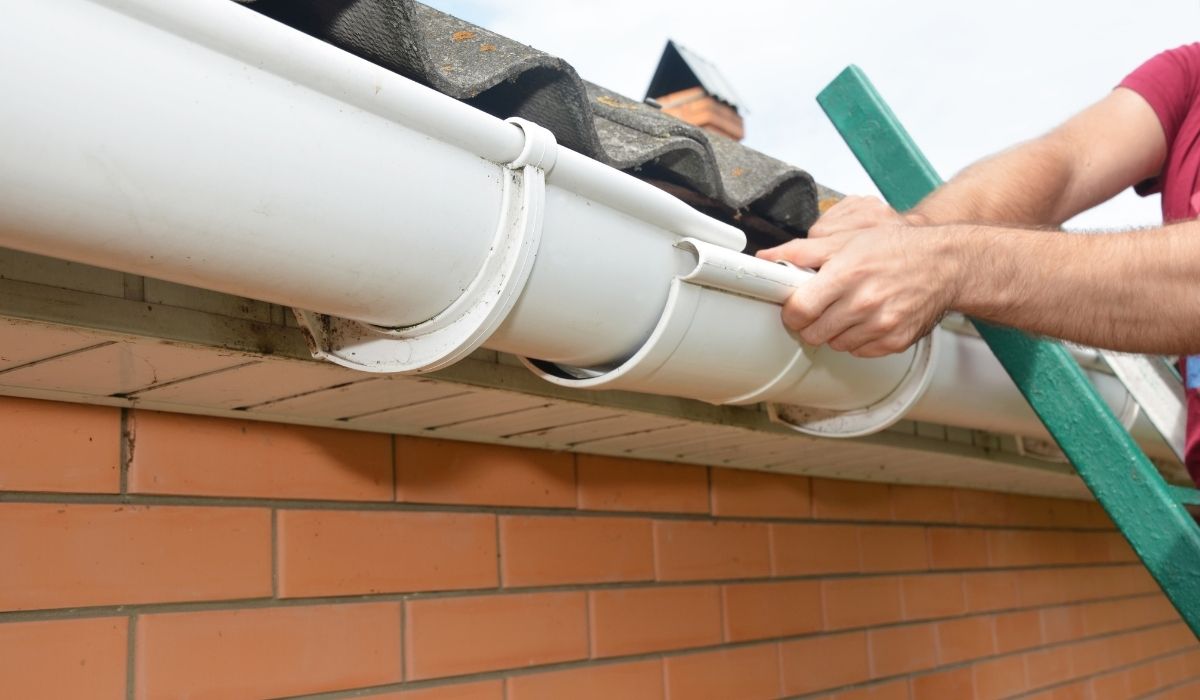Installing Rain Gutters? Here’s What You Should and Shouldn’t Do
When most homeowners think about home protection, they imagine locks, cameras, alarms—and maybe even storm shutters.
But there’s one crucial feature that quietly does the heavy lifting every time it rains: your rain gutters.
Rain gutters might not be the flashiest part of your home’s exterior, but they are absolutely essential.
They guide rainwater away from your house, helping to prevent basement flooding, roof damage, foundation issues, and even mold or mildew.
Installing gutters the right way can save you thousands in future repair costs. But doing it wrong—or neglecting them altogether—can invite serious trouble.
In this article, we’ll walk you through everything you should do when installing rain gutters, as well as the common mistakes to avoid. If you want to protect your home and boost its long-term value, this guide is for you.
✅ What You Should Do When Installing Rain Gutters

1. Do Choose the Right Gutter Material for Your Home
Rain gutters come in a variety of materials, each with its unique benefits and tradeoffs.
Picking the right material depends on your budget, local climate, the look of your home, and how much maintenance you’re willing to do.
Here are the most popular types:
- Aluminum Gutters: These are by far the most common choice. They’re lightweight, rust-proof, and come in many colors. They’re also affordable and easy to install.
- Copper Gutters: These are high-end and often chosen for historic or custom homes. They age beautifully, developing a greenish patina, and can last 50+ years with minimal upkeep.
- Steel Gutters: Galvanized steel is extremely durable and can withstand heavy snow or storms. However, it may rust over time if not properly maintained.
- Vinyl Gutters: These are the most budget-friendly and easiest for DIYers to install. However, vinyl can crack in cold climates and degrade faster under sun exposure.
What to do: Talk with a professional gutter installer about your region’s weather, your home’s design, and how long you plan to live there. Choosing the right gutter material upfront makes a huge difference in performance and longevity.
2. Do Opt for Seamless Gutters Whenever Possible
Seamless gutters are custom-built on-site to fit your home perfectly.
Unlike sectional gutters, which are pieced together in shorter lengths (and often leak at the seams), seamless gutters have no joints except at corners and downspouts.
Why they’re better:
- Fewer seams mean fewer leaks.
- They’re easier to clean and maintain.
- They offer a cleaner, more attractive appearance.
While seamless gutters may cost a bit more than sectional ones, the long-term savings on maintenance and repairs often outweigh the initial investment.
Bottom line: Also gutters offer superior performance, especially in that areas having heavy rainfall or debris buildup.
3. Do Ensure Proper Gutter Slope for Water Flow
A common mistake in DIY installations is overlooking the slope, or pitch, of the gutter. If your gutters don’t slope properly, rainwater won’t drain correctly—and that can lead to standing water, sagging gutters, or even overflowing.
What’s the right slope?
Generally, gutters should have a slope of about 1/4 inch for every 10 feet of length toward the nearest downspout.
What to do: Use a level and measuring tape to ensure that slope is accurate. This is where a professional’s touch really helps—they’ll know how to make it look straight from a distance while still ensuring optimal drainage.
4. Do Install the Right Number of Downspouts in the Right Places
Downspouts are the vertical sections of gutter that carry water from the horizontal gutters down and away from your home’s foundation.
Why they matter:
- Too few downspouts mean water can overflow and damage siding or landscaping.
- Poor placement can lead to water pooling near your foundation or seeping into your basement.
Best practices:
- Install one downspout for every 30–40 feet of gutter.
- Make sure downspouts channel water at least 3 feet away from your home (use splash blocks or downspout extenders if needed).
- Route water toward a drain, rain barrel, or grassy slope where it can disperse safely.
Tip: A well-planned downspout system is just as important as the gutters themselves. Don’t let water collect where it shouldn’t.
5. Do Regularly Clean and Inspect Your Gutters
Installing gutters is just step one—maintenance is what keeps them working for years to come.
Clogged gutters can cause water to overflow, damaging your roof, and even your foundation.
Maintenance tips:
- Clean your gutters at least twice a year—in the spring and fall.
- If you have lots of trees nearby, check them more often (every 3 months).
- Use a hose to flush out debris, or hire a professional for a more thorough job.
- While cleaning, inspect for signs of damage: rust, cracks, sagging, or loose hangers.
A 30-minute inspection can prevent thousands in repair bills later on.
❌ What You Shouldn’t Do When Installing Rain Gutters
1. Don’t Attempt a DIY Installation Unless You’re Experienced
Installing gutters may seem simple, but it actually requires careful measurements, precise angles, knowledge of your home’s structure, and access to safety equipment.
DIY risks include:
- Gutters that sag or pull away
- Water that drains in the wrong direction
- Gaps between sections that leak
- Injuries from ladders or roof work
What to do instead: Hire a licensed, insured professional who guarantees their work.
They’ll have the tools, experience, and training to install your gutters safely and correctly the first time.
2. Don’t Install Gutters on Rotting Fascia Boards
Gutters attach to fascia boards, which are the horizontal strips of wood that run along your roof edge.
If these are soft, cracked, or rotting, your gutters won’t hold up, and may fall off during the next storm.
Check for:
- Discoloration
- Wood that feels spongy when poked
- Signs of insects or mold
What to do: Replace damaged fascia before installation. If your home is older, ask your contractor to inspect the fascia and soffit before beginning any gutter work.
3. Don’t Ignore Your Area’s Rainfall Volume and Roof Size
Gutter systems should be customized to fit your specific home—and that includes the pitch and size of your roof, as well as how much rainfall you typically receive.
For example:
- Homes in the Southeast or Pacific Northwest may need larger 6-inch gutters.
- Flat or low-slope roofs may require extra downspouts to prevent overflow.
- Steep roofs may shed water faster, needing stronger gutters and better anchoring.
What to do: Talk to a local gutter specialist who understands your region’s climate. A one-size-fits-all gutter just won’t cut it.
4. Don’t Forget Gutter Guards—Especially if You Have Trees Nearby
If your home is shaded by trees, leaves, and twigs are going to end up in your gutters. Over time, this debris leads to clogs, water backups, ice dams in winter, and even pest infestations.
Gutter guards are protective covers that keep leaves out while letting water through.
But beware: Not all guards work the same. Cheap plastic mesh may collapse or let pine needles through. Instead, invest in:
- Micromesh guards
- Surface tension systems
- Professionally installed covers
What to do: If you’re already installing new gutters, ask about adding guards. They save you a lot of time, hassle, and repairs in the long run.
5. Don’t Use Too Few Gutter Hangers or Fasteners
Gutters must be properly supported to bear the weight of heavy rain, snow, and debris. Using too few hangers will cause sagging, separation from the fascia, or even total failure during a storm.
Guideline:
- Place hangers every 2 to 3 feet along the length of the gutter.
- Use heavy-duty screws or hidden brackets, not nails that can loosen over time.
What to do: Make sure your contractor uses appropriate fasteners and spacing for your roof type, local weather conditions, and gutter material.
⚠️ How to Tell If Your Gutters Were Installed Incorrectly
Sometimes problems don’t show up right away. Here are some signs your gutters weren’t installed correctly:
- Water overflows even in light rain
- Sagging or pulling away from the roofline
- Dripping at joints or seams
- Mold or mildew on siding near gutter edges
- Puddles forming around the foundation after rainfall
If you notice any of these, call a trusted gutter professional immediately to inspect and repair the system before bigger issues arise.
🌧️ Why Gutters Are Non-Negotiable for Homeowners
Still thinking gutters are optional? Let’s recap why they matter:
- Protect your foundation from erosion and cracks
- Keep your basement dry and free from mold
- Preserve your siding, windows, and doors
- Prevent landscape washout and garden damage
- Extend the life of your roof and home exterior
Ignoring your gutters can turn a $1,500 installation into a $15,000 water damage repair. It’s simply not worth the risk.
📣 Call to Action: Get Gutter Installation Done Right
If you’re building a new home or replacing old gutters, don’t cut corners. Invest in quality materials, expert installation, and smart design.
✅ We offer free consultations
✅ Seamless and sectional options available
✅ Leaf guard solutions for every roof type
✅ Fast, clean, professional service
✅ Licensed, bonded, and insured
👉 Contact us now to schedule your free gutter assessment and protect your home before the next storm hits!
FAQs
How long does it take to install gutters on a typical home?
Most homes can have gutters installed in just one day. Larger or two-story homes might take longer, but a professional team works quickly and efficiently to finish the job safely.
What size gutters are right for my home?
Standard homes use 5-inch gutters, while homes with larger roofs or heavier rainfall may need 6-inch ones. A professional will assess your needs based on local weather and roof size.
Can I install gutters in the winter?
Yes, but cold weather can impact sealants and safety. Spring and fall are best for installation, though winter installs are fine if conditions are safe or the job is urgent.
What are the benefits of seamless gutters?
Seamless gutters reduce leaks, require less maintenance, and offer a clean, custom fit. Since they’re cut on-site, they last longer and handle water more efficiently than sectional gutters.
Are gutter guards worth the investment?
Absolutely—especially if you have trees nearby. They prevent clogs, reduce maintenance, and help your gutters last longer by keeping out debris, leaves, and even pests.
How often should I clean my gutters?
Twice a year is standard—once in spring and again in fall. If your home is near lots of trees, consider cleaning them more often or installing gutter guards for added protection.
Do new gutters increase home value?
Yes. New gutters improve curb appeal and signal proper maintenance, which is appealing to potential buyers. They also help avoid costly structural problems down the road.
Will my gutters work during heavy storms?
If installed properly with the right size and slope, yes. Oversized gutters, extra downspouts, and guards ensure your system can handle even the heaviest downpours effectively.

